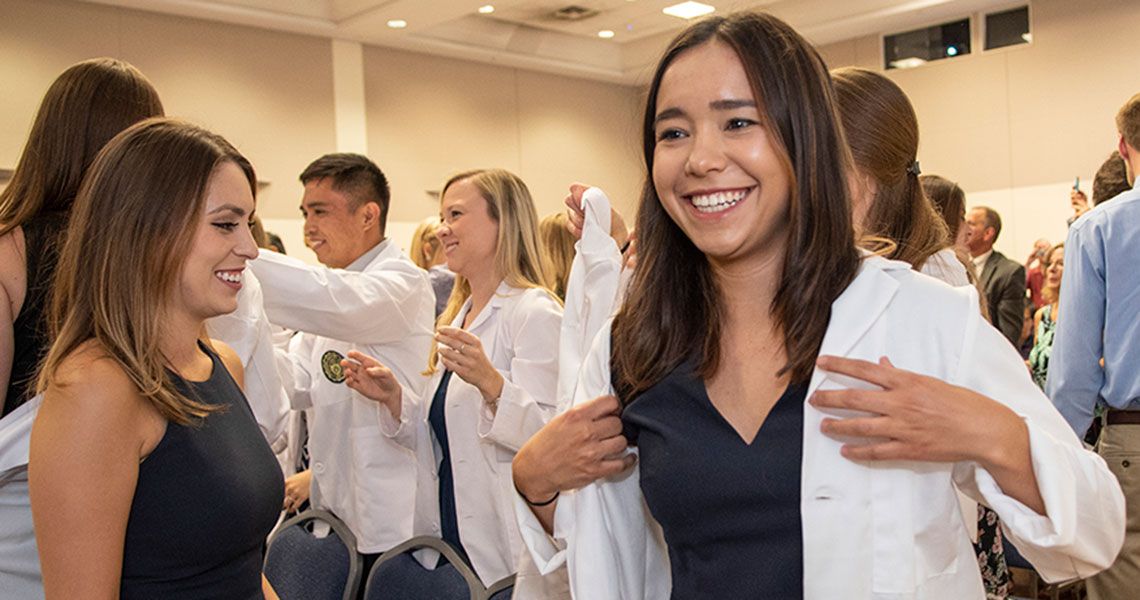David Keahey was home in Salt Lake City when he woke one morning with escalating abdominal pain. As a physician assistant (PA), he was well-versed in the signs of trouble, so when the pain continued to climb, he did what most would do: he called an Uber to go to the hospital.
“I wasn’t about to take an ambulance,” said Keahey, PA-C, chief policy and research officer at the Physician Assistant Education Association and the keynote speaker at the 2018 PA White Coat and Convocation at the George Washington University (GW) School of Medicine and Health Sciences (SMHS).
So began an odyssey in the emergency room, he continued, until he was put under observation for 23 hours and his pain reached a “nine out of 10.” Then, to his surprise, he saw a PA he had taught more than 15 years before. “And I pause, not for humor, but for trying to choke back tears,” he said. “Here was this student that I had taught, and before that time was over, three more people I had taught at some point during their training came in to take care of me. There was a circle completed there. … So be prepared to be accountable for everything you do.”
PAs, he added, shoulder a heavy load of responsibility for their patients, symbolized by the donning of their short white coats, a ceremonial milestone in their professional journey.
“It marks the time when students can begin seeing patients,” he said. “There is just nothing like being with a patient to bring home what all this hard work and sacrifice is about.”
Although the new crop of PA students just started classes in early June, their immersion has already included quizzes and exams, standard fare for the prestigious program.
Currently, the SMHS PA program is ranked third in the country, according to U.S. News and World Report, and, as Karen Wright, PhD, program director for the PA program, assistant dean for student life and academic support for health sciences, and assistant professor of physician assistant studies at SMHS, explained at the ceremony, there are ample opportunities for PAs. It’s consistently ranked as one of the top jobs — the second in health care — and is likely to see a 27 percent increase by 2021.
“It is clear that PAs are highly valued members of the health care team,” she said.
As the Class of 2020 embarks on the path of what Keahey termed an “innovative, unique profession,” members of the SMHS community provided pearls of wisdom to help guide the budding clinicians. From Keahey, based on what he looked for as a preceptor, they learned PAs need to be intelligent, empathetic, and hungry, striving to answer their own questions while being self-aware and pragmatic.
Second-year PA students Victoria Eskay and Shannen Renehan, who both serve as co-presidents of the James K. Tolton Student Society, urged their new classmates to get involved in everything that SMHS has to offer: advocating for the PA profession on Capitol Hill; raising money for PA-based philanthropies; volunteering at the GW Healing Clinic, Miriam’s Kitchen, and the Capital Area Food Bank; and introducing area high school students to potential health care career opportunities through GW Office of Diversity and Inclusion-sponsored pipeline programs.
“Always be present and engaged,” added Eskay. “Keep going and don’t give up. You’ll get there.”
And from Susan LeLacheur, DrPH ’08, MPH ’89, PA-C, BS ’80, associate professor of physician assistant studies at SMHS, they learned the meaning of the white coat: “to stand under.”
“It is [the] white coat that signifies service, that signifies understanding, and only by standing under it, can you look up to your patient and gain what they are bringing to you,” she said. “What that allows you to do is reach out with both hands and offer them that understanding.”
LeLacheur, for example, had treated a patient who had a difficult home life just a week earlier.
“I didn’t know how to understand her,” she recalled. “I realized pretty quickly, she knew I couldn’t do everything for her, but she also knew I had a use, and I maybe had a heart. I finally opened that heart and listened and gave her a moment and just shared her suffering.”
Sharing in a patient’s suffering is precisely the kind of responsibility the white coat confers, LeLacheur added. “When you put on that white coat, it is saying that you have the privilege and the honor to care for patients … to share in the lives of others and help them carry their suffering.”
Following her words, and with help from the second-year PA students behind them, members of the Class of 2020 officially donned their short white coats to applause and recited the PA student pledge.
One more piece of advice awaited the students, however; tucked inside each coat pocket was a note from PA alumni, who also provided the funds for the coats.
“It’s a nice personal touch; it’s a connection to students who’ve gone through the program before,” said first-year PA student Jeremy Birch. “[My letter] was encouraging, warm, and inspiring.”



